FMCG Market Size 2025-2029
The FMCG market size is valued to increase by USD 456.9 billion, at a CAGR of 3.2% from 2024 to 2029. Growing preference for e-commerce online distribution will drive the FMCG market.
Major Market Trends & Insights
- APAC dominated the market and accounted for a 44% growth during the forecast period.
- By Type - Food and beverage segment was valued at USD 1277.40 billion in 2023
- By Distribution Channel - Offline segment accounted for the largest market revenue share in 2023
Market Size & Forecast
- Market Opportunities: USD 27.75 billion
- Market Future Opportunities: USD 456.90 billion
- CAGR from 2024 to 2029 : 3.2%
Market Summary
- The Fast-Moving Consumer Goods (FMCG) market continues to experience significant shifts, driven by evolving consumer preferences and advancements in technology. The increasing popularity of e-commerce platforms for FMCG purchases has disrupted traditional distribution channels, leading to a more convenient and accessible shopping experience for consumers. Simultaneously, the demand for ready-to-eat food products has surged due to hectic lifestyles and the growing trend of on-the-go meals. Despite this progress, challenges persist, particularly in emerging economies where infrastructure development lags behind. Inadequate storage facilities and transportation networks can hinder the efficient distribution of FMCG products, leading to spoilage and supply chain disruptions.
- However, these hurdles also present opportunities for innovation and investment in modern logistics solutions. As the market adapts to these trends and challenges, it remains a dynamic and vital sector for businesses worldwide. Companies must stay agile and responsive to consumer demands, leveraging technology and strategic partnerships to navigate the complex landscape and capitalize on emerging opportunities. The future of the market promises continued growth and transformation, as it adapts to the evolving needs and preferences of consumers in an increasingly interconnected and globalized world.
What will be the Size of the FMCG Market during the forecast period?
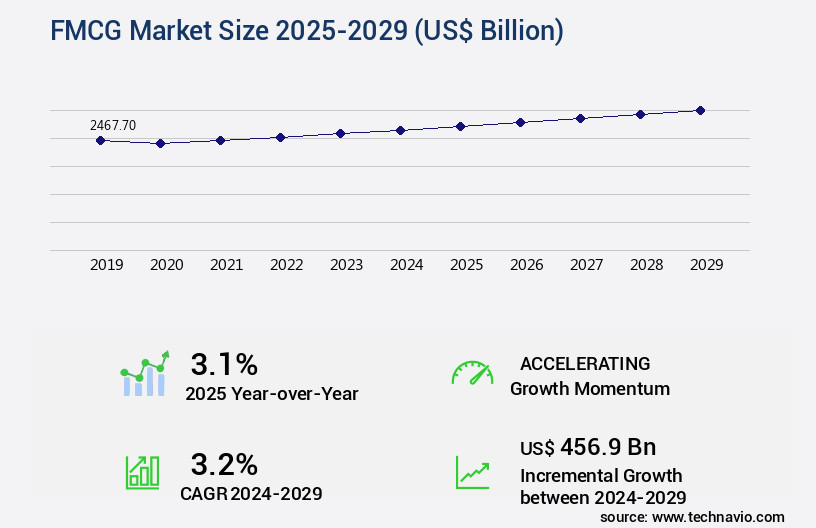
Get Key Insights on Market Forecast (PDF) Request Free Sample
How is the FMCG Market Segmented ?
The FMCG industry research report provides comprehensive data (region-wise segment analysis), with forecasts and estimates in "USD billion" for the period 2025-2029, as well as historical data from 2019-2023 for the following segments.
- Type
- Food and beverage
- Personal and beauty care
- Health and hygiene care
- Home care
- Distribution Channel
- Product Type
- Premium
- Mass market
- Private label
- Production Type
- Geography
- North America
- Europe
- Middle East and Africa
- APAC
- South America
- Rest of World (ROW)
By Type Insights
The food and beverage segment is estimated to witness significant growth during the forecast period.
In the dynamic and ever-evolving world of fast-moving consumer goods (FMCG), the food and beverage sector experienced a significant surge in demand during 2024. This growth was driven by improving economic conditions and increasing disposable income levels in both developed and developing countries. As a response, manufacturers have been investing in advanced food processing and packaging solutions to cater to this expanding market. Product differentiation has become a key focus for companies, with innovative new offerings such as Thomas's October 2023 launch of a croissant bread, which combines the flaky layers of a croissant with the convenience of sliced bread.
In this competitive landscape, effective marketing mix modeling, supply chain visibility, and consumer insights are essential. Quality control measures, inventory control, and sales performance indicators are crucial for maintaining brand loyalty and market share. Retailer relationships, consumer segmentation, and data analytics are also vital for demand planning and e-commerce platform success. With the increasing importance of digital marketing and social media engagement, product traceability and product lifecycle management are becoming increasingly important for transparency and customer trust. The market is expected to continue its growth trajectory, with consumer packaged goods companies continually refining their marketing campaign effectiveness, sales promotion strategies, and pricing strategies to meet evolving consumer behavior patterns.
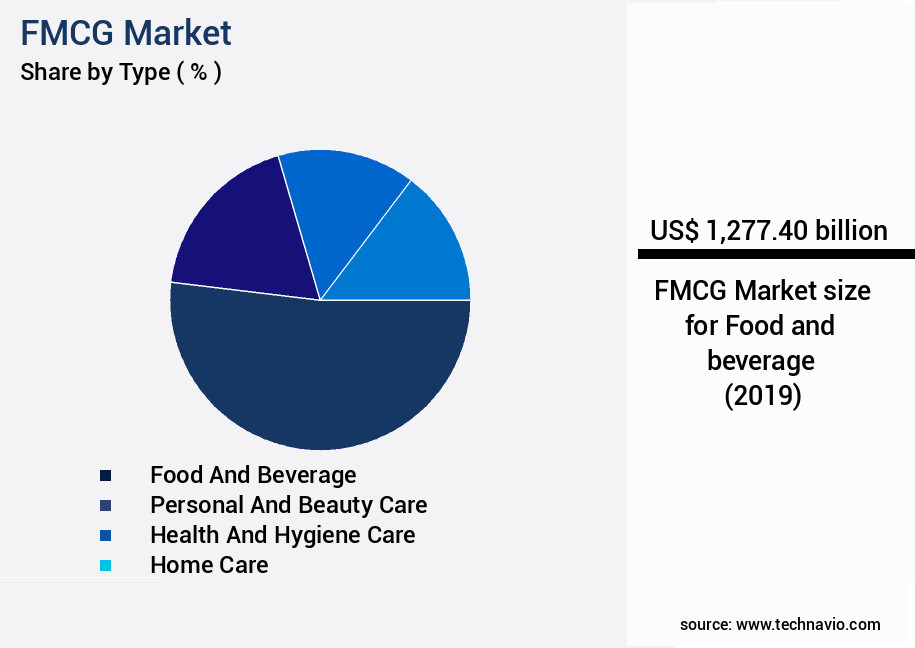
Request Free Sample
The Food and beverage segment was valued at USD 1277.40 billion in 2019 and showed a gradual increase during the forecast period.
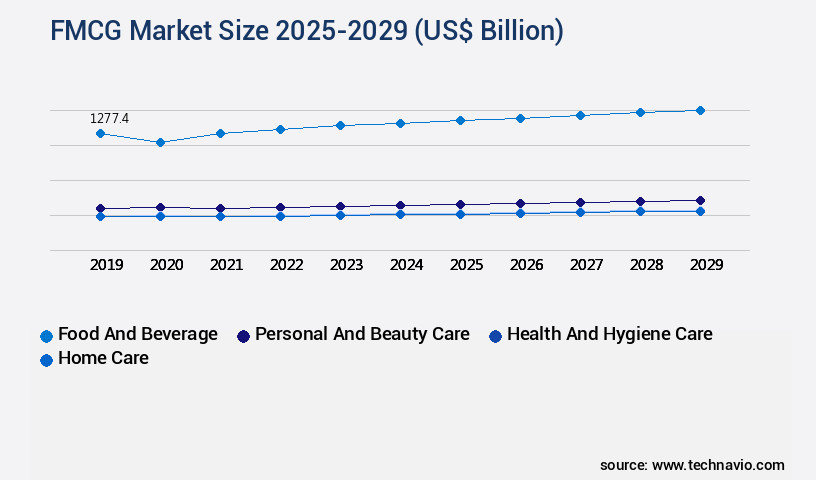
Request Free Sample
Regional Analysis
APAC is estimated to contribute 44% to the growth of the global market during the forecast period.Technavio's analysts have elaborately explained the regional trends and drivers that shape the market during the forecast period.
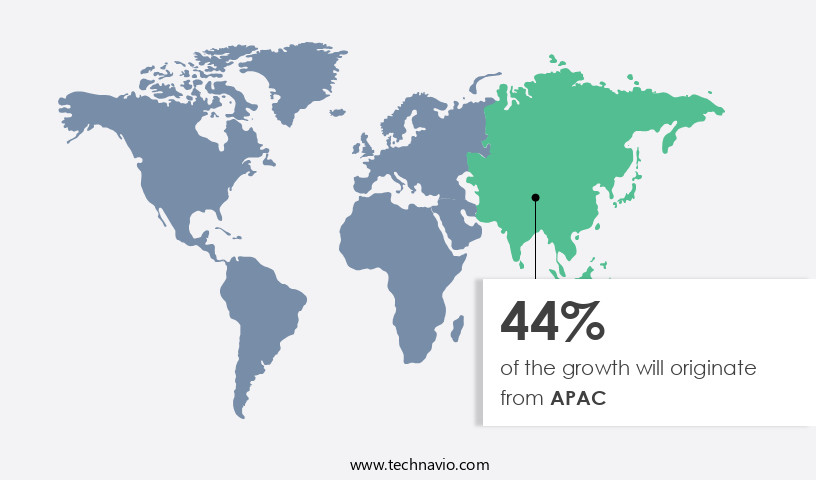
See How FMCG Market Demand is Rising in APAC Request Free Sample
The Asia Pacific (APAC) region is a significant contributor to the Fast-Moving Consumer Goods (FMCG) market, with major revenue generators including China, India, Japan, South Korea, Indonesia, Singapore, and Australia. The region's expanding population, increasing disposable income, and evolving consumer preferences are key drivers for the demand in personal care products, food and beverages, consumer goods, and medicines. Concurrently, the retail and manufacturing sectors are experiencing growth in countries like China, India, Japan, South Korea, Australia, and Indonesia. In the retail sector, companies are implementing promotional campaigns to attract customers. Urbanization and changing lifestyles further fuel the market's continuous evolution in APAC.
Market Dynamics
Our researchers analyzed the data with 2024 as the base year, along with the key drivers, trends, and challenges. A holistic analysis of drivers will help companies refine their marketing strategies to gain a competitive advantage.
The Fast-Moving Consumer Goods (FMCG) market is a dynamic and competitive business landscape, requiring effective promotional campaign strategies to capture consumer attention. Optimizing supply chain efficiency is crucial in the FMCG sector to ensure timely delivery and minimize stockouts. Understanding consumer behavior and purchasing patterns is essential for FMCG companies to measure marketing campaign return on investment and improve inventory management in distribution. Data analytics plays a pivotal role in enhancing FMCG sales performance by providing insights into consumer preferences and market trends. FMCG product lifecycle management and optimization help companies extend the life of their products and maximize profits. Building brand loyalty in the FMCG sector can be achieved through strategies such as developing effective pricing strategies, implementing sustainable packaging solutions, and customer segmentation and targeted marketing.
Social media is an effective tool for building brand awareness in the FMCG sector, allowing companies to reach a large and diverse audience. Analyzing the FMCG customer journey and experience is crucial for identifying pain points and opportunities for improvement. Optimizing e-commerce logistics and managing retailer relationships efficiently are essential for FMCG companies to meet customer demands and maintain strong partnerships. Effective quality control and assurance is necessary in the FMCG sector to ensure product safety and meet regulatory compliance. Predictive analytics for FMCG demand forecasting helps companies anticipate market trends and adjust production accordingly. Efficient warehouse management systems and the new product development process are essential for managing inventory and bringing new products to market quickly and cost-effectively. Managing product recalls and regulatory compliance is crucial for maintaining brand reputation and customer trust.
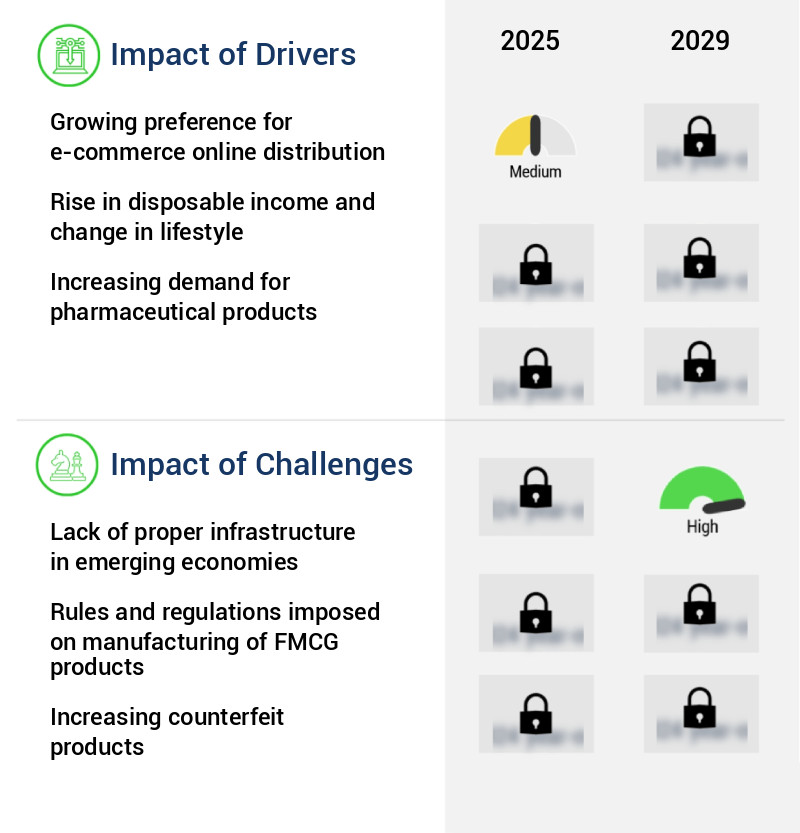
What are the key market drivers leading to the rise in the adoption of FMCG Industry?
- The increasing trend toward e-commerce and online distribution is the primary market driver.
- The market has experienced significant evolution in recent years, with e-commerce playing a pivotal role in driving sales. This shift can be attributed to the convenience and wide product range offered by e-commerce platforms. For instance, consumers can now easily purchase a diverse selection of kombucha brands online. The global increase in smartphone usage has contributed to the surge in e-commerce companies, catering to the growing demand for online FMCG purchases. Consumers appreciate the personalized shopping assistance and product suggestions provided by these platforms.
- Furthermore, e-commerce enables users to gather information and compare various food and beverage, personal care, skincare, cosmetics, and hair care products available on the website. This trend underscores the importance of e-commerce in the FMCG sector and highlights its potential applications across various industries.
What are the market trends shaping the FMCG Industry?
- The consumption of ready-to-eat food products is increasingly popular and represents an emerging market trend.
- The market is experiencing a dynamic evolution, with the ready-to-eat (RTE) food sector emerging as a significant growth area. This shift is influenced by shifting consumer preferences, urbanization, and increasing disposable incomes. The burgeoning population of working professionals, dual-income households, and students is fueling demand for convenient meal solutions that require minimal preparation time while delivering nutritional value. Advancements in food processing and packaging technologies, such as modified atmosphere packaging (MAP), vacuum sealing, and microwaveable packaging, have significantly boosted the RTE sector. These innovations enhance product shelf life, improve quality, and offer added convenience. Furthermore, the surge in e-commerce penetration and online grocery platforms has made RTE products more accessible to a broader consumer base.
- The convenience food market is projected to grow at a robust pace, with RTE foods accounting for a substantial market share. For instance, the RTE segment is estimated to account for over 20% of the market share, while the global RTE food packaging market is projected to reach a value of over USD50 billion by 2025, growing at a CAGR of around 5%.
What challenges does the FMCG Industry face during its growth?
- In emerging economies, the absence of adequate infrastructure represents a significant obstacle to the expansion and growth of industries.
- The Fast-Moving Consumer Goods (FMCG) market is experiencing significant growth in emerging economies, particularly in the Asia Pacific (APAC) region. This expansion is driven by several factors, including improving economic conditions, urbanization, and increasing health consciousness. The food processing industry's growth in these regions further boosts the demand for FMCG products. However, APAC faces challenges in providing adequate infrastructure for storing and manufacturing essential food processing ingredients, such as preservatives, emulsifiers, and enzymes.
- Proper handling and care, including maintaining specific temperatures and preventing contamination, are crucial to preserve these ingredients' chemical compositions. Despite these challenges, the market's potential for growth in APAC remains robust.
Exclusive Technavio Analysis on Customer Landscape
The fmcg market forecasting report includes the adoption lifecycle of the market, covering from the innovator's stage to the laggard's stage. It focuses on adoption rates in different regions based on penetration. Furthermore, the fmcg market report also includes key purchase criteria and drivers of price sensitivity to help companies evaluate and develop their market growth analysis strategies.
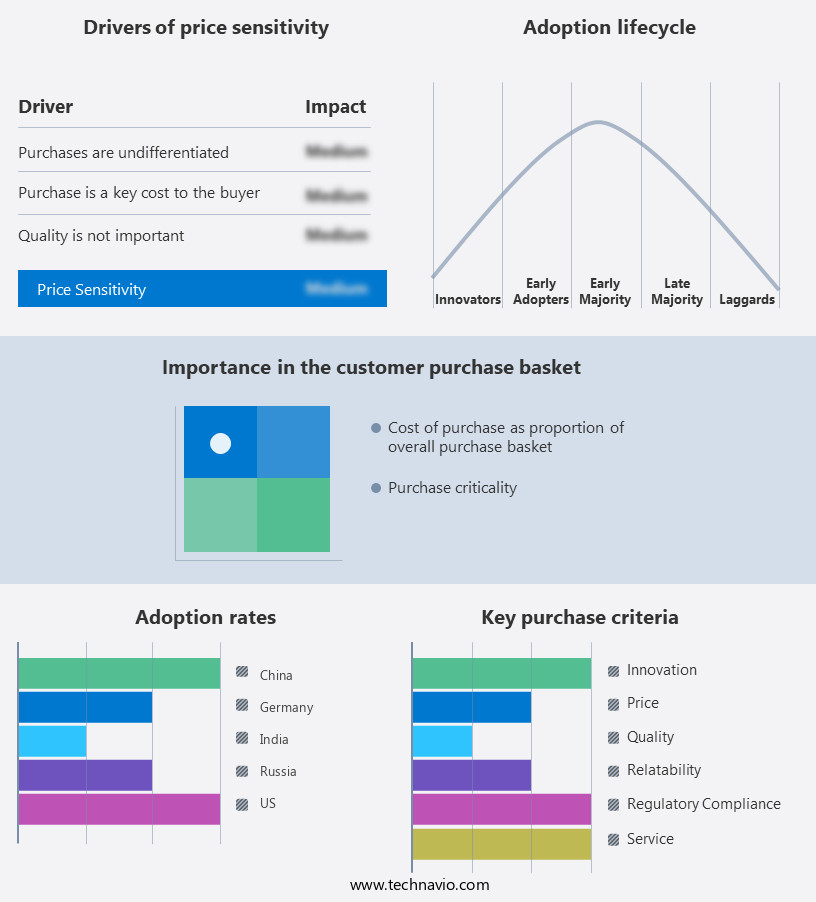
Customer Landscape of FMCG Industry
Competitive Landscape
Companies are implementing various strategies, such as strategic alliances, fmcg market forecast, partnerships, mergers and acquisitions, geographical expansion, and product/service launches, to enhance their presence in the industry.
Associated British Foods - This company specializes in Fast-Moving Consumer Goods (FMCG), producing a range of items including anti-aging cream, toothpaste, and hair oil. Their product offerings cater to various personal care needs, showcasing a commitment to innovation and consumer satisfaction.
The industry research and growth report includes detailed analyses of the competitive landscape of the market and information about key companies, including:
- Associated British Foods
- Colgate-Palmolive
- Danone
- Godrej Consumer Products Ltd.
- Grupo Bimbo SAB de CV
- JBS S.A.
- Kimberly-Clark Corp.
- Kraft Heinz Co.
- L'Oréal SA
- Marico Limited
- Mondelez International Inc.
- Nestlé SA
- PepsiCo
- Procter & Gamble Co
- Reckitt Benckiser Group PLC
- Tyson Foods Inc.
- Unilever PLC
- Wilmar International Ltd.
Qualitative and quantitative analysis of companies has been conducted to help clients understand the wider business environment as well as the strengths and weaknesses of key industry players. Data is qualitatively analyzed to categorize companies as pure play, category-focused, industry-focused, and diversified; it is quantitatively analyzed to categorize companies as dominant, leading, strong, tentative, and weak.
Recent Development and News in FMCG Market
- In August 2024, Unilever, a leading FMCG company, announced the launch of its new plant-based meat alternative brand, "V-Leaf," in partnership with Greenleaf Foods, a subsidiary of Maple Leaf Foods (Reuters, 2024). This strategic collaboration aimed to cater to the growing demand for sustainable and ethical food options.
- In November 2024, Nestle, the world's largest FMCG company, completed the acquisition of Aimmune Therapeutics, a biotech firm specializing in peanut allergy treatments, for approximately USD2.6 billion (Bloomberg, 2024). This acquisition expanded Nestle's portfolio into the medical nutrition sector, positioning the company to offer innovative solutions for food allergies.
- In March 2025, PepsiCo and Starbucks entered a strategic partnership to co-create, manufacture, and distribute Starbucks' ready-to-drink coffee products under the Starbucks and Tazo brands (Wall Street Journal, 2025). This collaboration enabled PepsiCo to strengthen its position in the coffee market and Starbucks to expand its reach beyond its traditional retail stores.
- In May 2025, the European Commission approved the merger of Danone and WhiteWave Foods, creating a leading player in The market (European Commission Press Release, 2025). This merger combined Danone's dairy and water businesses with WhiteWave's plant-based food and beverage offerings, allowing the new entity to cater to diverse consumer preferences.
Dive into Technavio's robust research methodology, blending expert interviews, extensive data synthesis, and validated models for unparalleled FMCG Market insights. See full methodology.
|
Market Scope
|
|
Report Coverage
|
Details
|
|
Page number
|
218
|
|
Base year
|
2024
|
|
Historic period
|
2019-2023 |
|
Forecast period
|
2025-2029
|
|
Growth momentum & CAGR
|
Accelerate at a CAGR of 3.2%
|
|
Market growth 2025-2029
|
USD 456.9 billion
|
|
Market structure
|
Fragmented
|
|
YoY growth 2024-2025(%)
|
3.1
|
|
Key countries
|
US, Canada, Germany, UK, Italy, France, China, India, Japan, Brazil, Egypt, UAE, Oman, Argentina, KSA, UAE, Brazil, and Rest of World (ROW)
|
|
Competitive landscape
|
Leading Companies, Market Positioning of Companies, Competitive Strategies, and Industry Risks
|
Request Free Sample
Research Analyst Overview
- The fast-moving consumer goods (FMCG) market continues to evolve, with ongoing activities shaping its dynamics across various sectors. Shelf life optimization and marketing mix modeling are crucial strategies for FMCG companies, ensuring product quality and effective marketing campaigns. Quality control measures and supply chain visibility are essential components of the production process, enabling timely response to consumer behavior patterns and insights. Logistics and transportation, customer relationship management, and distribution channels are integral to delivering products to consumers efficiently. New product development, retail inventory management, and inventory control are essential for maintaining sales performance indicators and product traceability.
- Product lifecycle management, social media engagement, and retailer relationships contribute to brand loyalty metrics and market share dynamics. The FMCG industry anticipates significant growth, with expectations of a 3% annual expansion. For instance, a leading FMCG company successfully increased sales by 5% through effective pricing strategies and data analytics, highlighting the importance of these tactics. The market is further influenced by consumer packaged goods trends, such as product differentiation, demand forecasting, and e-commerce platforms. Customer segmentation and sales promotion strategies are also key elements of digital marketing efforts. In summary, the market is characterized by continuous dynamism, with companies adapting to evolving consumer preferences and market conditions.
- Strategies like shelf life optimization, marketing mix modeling, and supply chain management play a vital role in navigating the complex landscape of consumer behavior patterns, logistics, and retail relationships.
What are the Key Data Covered in this FMCG Market Research and Growth Report?
-
What is the expected growth of the FMCG Market between 2025 and 2029?
-
What segmentation does the market report cover?
-
The report is segmented by Type (Food and beverage, Personal and beauty care, Health and hygiene care, and Home care), Distribution Channel (Offline and Online), Product Type (Premium, Mass market, and Private label), Geography (APAC, North America, Europe, Middle East and Africa, and South America), and Production Type (In-house and Contract-based)
-
Which regions are analyzed in the report?
-
APAC, North America, Europe, Middle East and Africa, and South America
-
What are the key growth drivers and market challenges?
-
Who are the major players in the FMCG Market?
-
Associated British Foods, Colgate-Palmolive, Danone, Godrej Consumer Products Ltd., Grupo Bimbo SAB de CV, JBS S.A., Kimberly-Clark Corp., Kraft Heinz Co., L'Oréal SA, Marico Limited, Mondelez International Inc., Nestlé SA, PepsiCo, Procter & Gamble Co, Reckitt Benckiser Group PLC, Tyson Foods Inc., Unilever PLC, and Wilmar International Ltd.
Market Research Insights
- The market for fast-moving consumer goods (FMCG) is a dynamic and ever-evolving landscape, characterized by constant innovation and adaptation to consumer preferences and trends. According to industry reports, The market is projected to grow by 3% annually over the next decade. For instance, sales of plant-based food and beverage products have experienced significant growth in recent years, with some categories seeing increases of up to 20%. This trend is driven by consumer demand for healthier and more sustainable options.
- Additionally, e-commerce channels have gained traction in the FMCG sector, with online sales accounting for over 15% of total sales in some regions. These figures underscore the importance of effective product portfolio management, retail operations, and e-commerce logistics for FMCG companies.
We can help! Our analysts can customize this FMCG market research report to meet your requirements.
Get in touch
1 Executive Summary
- 1.1 Market overview
- Executive Summary - Chart on Market Overview
- Executive Summary - Data Table on Market Overview
- Executive Summary - Chart on Global Market Characteristics
- Executive Summary - Chart on Market by Geography
- Executive Summary - Chart on Market Segmentation by Type
- Executive Summary - Chart on Market Segmentation by Distribution Channel
- Executive Summary - Chart on Market Segmentation by Product Type
- Executive Summary - Chart on Incremental Growth
- Executive Summary - Data Table on Incremental Growth
- Executive Summary - Chart on Company Market Positioning
2 Technavio Analysis
- 2.1 Analysis of price sensitivity, lifecycle, customer purchase basket, adoption rates, and purchase criteria
- Analysis of price sensitivity, lifecycle, customer purchase basket, adoption rates, and purchase criteria
- 2.2 Criticality of inputs and Factors of differentiation
- Overview on criticality of inputs and factors of differentiation
- 2.3 Factors of disruption
- Overview on factors of disruption
- 2.4 Impact of drivers and challenges
- Impact of drivers and challenges in 2024 and 2029
3 Market Landscape
- 3.1 Market ecosystem
- Parent Market
- Data Table on - Parent Market
- 3.2 Market characteristics
- Market characteristics analysis
4 Market Sizing
- 4.1 Market definition
- Offerings of companies included in the market definition
- 4.2 Market segment analysis
- 4.4 Market outlook: Forecast for 2024-2029
- Chart on Global - Market size and forecast 2024-2029 ($ billion)
- Data Table on Global - Market size and forecast 2024-2029 ($ billion)
- Chart on Global Market: Year-over-year growth 2024-2029 (%)
- Data Table on Global Market: Year-over-year growth 2024-2029 (%)
5 Historic Market Size
- 5.1 Global FMCG Market 2019 - 2023
- Historic Market Size - Data Table on Global FMCG Market 2019 - 2023 ($ billion)
- 5.2 Type segment analysis 2019 - 2023
- Historic Market Size - Type Segment 2019 - 2023 ($ billion)
- 5.3 Distribution Channel segment analysis 2019 - 2023
- Historic Market Size - Distribution Channel Segment 2019 - 2023 ($ billion)
- 5.4 Product Type segment analysis 2019 - 2023
- Historic Market Size - Product Type Segment 2019 - 2023 ($ billion)
- 5.5 Geography segment analysis 2019 - 2023
- Historic Market Size - Geography Segment 2019 - 2023 ($ billion)
- 5.6 Country segment analysis 2019 - 2023
- Historic Market Size - Country Segment 2019 - 2023 ($ billion)
6 Qualitative Analysis
- 6.1 Impact of AI on the Global FMCG market
7 Five Forces Analysis
- 7.1 Five forces summary
- Five forces analysis - Comparison between 2024 and 2029
- 7.2 Bargaining power of buyers
- Bargaining power of buyers - Impact of key factors 2024 and 2029
- 7.3 Bargaining power of suppliers
- Bargaining power of suppliers - Impact of key factors in 2024 and 2029
- 7.4 Threat of new entrants
- Threat of new entrants - Impact of key factors in 2024 and 2029
- 7.5 Threat of substitutes
- Threat of substitutes - Impact of key factors in 2024 and 2029
- 7.6 Threat of rivalry
- Threat of rivalry - Impact of key factors in 2024 and 2029
- 7.7 Market condition
- Chart on Market condition - Five forces 2024 and 2029
8 Market Segmentation by Type
- 8.1 Market segments
- Chart on Type - Market share (2024-2029) (%)
- Data Table on Type - Market share (2024-2029) (%)
- 8.2 Comparison by Type
- Chart on Comparison by Type
- Data Table on Comparison by Type
- 8.3 Food and beverage - Market size and forecast (2024-2029)
- Chart on Food and beverage - Market size and forecast (2024-2029) ($ billion)
- Data Table on Food and beverage - Market size and forecast (2024-2029) ($ billion)
- Chart on Food and beverage - Year-over-year growth (2024-2029) (%)
- Data Table on Food and beverage - Year-over-year growth (2024-2029) (%)
- 8.4 Personal and beauty care - Market size and forecast (2024-2029)
- Chart on Personal and beauty care - Market size and forecast (2024-2029) ($ billion)
- Data Table on Personal and beauty care - Market size and forecast (2024-2029) ($ billion)
- Chart on Personal and beauty care - Year-over-year growth (2024-2029) (%)
- Data Table on Personal and beauty care - Year-over-year growth (2024-2029) (%)
- 8.5 Health and hygiene care - Market size and forecast (2024-2029)
- Chart on Health and hygiene care - Market size and forecast (2024-2029) ($ billion)
- Data Table on Health and hygiene care - Market size and forecast (2024-2029) ($ billion)
- Chart on Health and hygiene care - Year-over-year growth (2024-2029) (%)
- Data Table on Health and hygiene care - Year-over-year growth (2024-2029) (%)
- 8.6 Home care - Market size and forecast (2024-2029)
- Chart on Home care - Market size and forecast (2024-2029) ($ billion)
- Data Table on Home care - Market size and forecast (2024-2029) ($ billion)
- Chart on Home care - Year-over-year growth (2024-2029) (%)
- Data Table on Home care - Year-over-year growth (2024-2029) (%)
- 8.7 Market opportunity by Type
- Market opportunity by Type ($ billion)
- Data Table on Market opportunity by Type ($ billion)
9 Market Segmentation by Distribution Channel
- 9.1 Market segments
- Chart on Distribution Channel - Market share (2024-2029) (%)
- Data Table on Distribution Channel - Market share (2024-2029) (%)
- 9.2 Comparison by Distribution Channel
- Chart on Comparison by Distribution Channel
- Data Table on Comparison by Distribution Channel
- 9.3 Offline - Market size and forecast (2024-2029)
- Chart on Offline - Market size and forecast (2024-2029) ($ billion)
- Data Table on Offline - Market size and forecast (2024-2029) ($ billion)
- Chart on Offline - Year-over-year growth (2024-2029) (%)
- Data Table on Offline - Year-over-year growth (2024-2029) (%)
- 9.4 Online - Market size and forecast (2024-2029)
- Chart on Online - Market size and forecast (2024-2029) ($ billion)
- Data Table on Online - Market size and forecast (2024-2029) ($ billion)
- Chart on Online - Year-over-year growth (2024-2029) (%)
- Data Table on Online - Year-over-year growth (2024-2029) (%)
- 9.5 Market opportunity by Distribution Channel
- Market opportunity by Distribution Channel ($ billion)
- Data Table on Market opportunity by Distribution Channel ($ billion)
10 Market Segmentation by Product Type
- 10.1 Market segments
- Chart on Product Type - Market share (2024-2029) (%)
- Data Table on Product Type - Market share (2024-2029) (%)
- 10.2 Comparison by Product Type
- Chart on Comparison by Product Type
- Data Table on Comparison by Product Type
- 10.3 Premium - Market size and forecast (2024-2029)
- Chart on Premium - Market size and forecast (2024-2029) ($ billion)
- Data Table on Premium - Market size and forecast (2024-2029) ($ billion)
- Chart on Premium - Year-over-year growth (2024-2029) (%)
- Data Table on Premium - Year-over-year growth (2024-2029) (%)
- 10.4 Mass market - Market size and forecast (2024-2029)
- Chart on Mass market - Market size and forecast (2024-2029) ($ billion)
- Data Table on Mass market - Market size and forecast (2024-2029) ($ billion)
- Chart on Mass market - Year-over-year growth (2024-2029) (%)
- Data Table on Mass market - Year-over-year growth (2024-2029) (%)
- 10.5 Private label - Market size and forecast (2024-2029)
- Chart on Private label - Market size and forecast (2024-2029) ($ billion)
- Data Table on Private label - Market size and forecast (2024-2029) ($ billion)
- Chart on Private label - Year-over-year growth (2024-2029) (%)
- Data Table on Private label - Year-over-year growth (2024-2029) (%)
- 10.6 Market opportunity by Product Type
- Market opportunity by Product Type ($ billion)
- Data Table on Market opportunity by Product Type ($ billion)
11 Market Segmentation by Production Type
- 11.1 Market segments
- Chart on Production Type - Market share (2024-2029) (%)
- Data Table on Production Type - Market share (2024-2029) (%)
- 11.2 Comparison by Production Type
- Chart on Comparison by Production Type
- Data Table on Comparison by Production Type
- 11.3 In-house - Market size and forecast (2024-2029)
- Chart on In-house - Market size and forecast (2024-2029) ($ billion)
- Data Table on In-house - Market size and forecast (2024-2029) ($ billion)
- Chart on In-house - Year-over-year growth (2024-2029) (%)
- Data Table on In-house - Year-over-year growth (2024-2029) (%)
- 11.4 Contract-based - Market size and forecast (2024-2029)
- Chart on Contract-based - Market size and forecast (2024-2029) ($ billion)
- Data Table on Contract-based - Market size and forecast (2024-2029) ($ billion)
- Chart on Contract-based - Year-over-year growth (2024-2029) (%)
- Data Table on Contract-based - Year-over-year growth (2024-2029) (%)
- 11.5 Market opportunity by Production Type
- Market opportunity by Production Type ($ billion)
- Data Table on Market opportunity by Production Type ($ billion)
12 Customer Landscape
- 12.1 Customer landscape overview
- Analysis of price sensitivity, lifecycle, customer purchase basket, adoption rates, and purchase criteria
13 Geographic Landscape
- 13.1 Geographic segmentation
- Chart on Market share by geography 2024-2029 (%)
- Data Table on Market share by geography 2024-2029 (%)
- 13.2 Geographic comparison
- Chart on Geographic comparison
- Data Table on Geographic comparison
- 13.3 APAC - Market size and forecast 2024-2029
- Chart on APAC - Market size and forecast 2024-2029 ($ billion)
- Data Table on APAC - Market size and forecast 2024-2029 ($ billion)
- Chart on APAC - Year-over-year growth 2024-2029 (%)
- Data Table on APAC - Year-over-year growth 2024-2029 (%)
- 13.4 North America - Market size and forecast 2024-2029
- Chart on North America - Market size and forecast 2024-2029 ($ billion)
- Data Table on North America - Market size and forecast 2024-2029 ($ billion)
- Chart on North America - Year-over-year growth 2024-2029 (%)
- Data Table on North America - Year-over-year growth 2024-2029 (%)
- 13.5 Europe - Market size and forecast 2024-2029
- Chart on Europe - Market size and forecast 2024-2029 ($ billion)
- Data Table on Europe - Market size and forecast 2024-2029 ($ billion)
- Chart on Europe - Year-over-year growth 2024-2029 (%)
- Data Table on Europe - Year-over-year growth 2024-2029 (%)
- 13.6 Middle East and Africa - Market size and forecast 2024-2029
- Chart on Middle East and Africa - Market size and forecast 2024-2029 ($ billion)
- Data Table on Middle East and Africa - Market size and forecast 2024-2029 ($ billion)
- Chart on Middle East and Africa - Year-over-year growth 2024-2029 (%)
- Data Table on Middle East and Africa - Year-over-year growth 2024-2029 (%)
- 13.7 South America - Market size and forecast 2024-2029
- Chart on South America - Market size and forecast 2024-2029 ($ billion)
- Data Table on South America - Market size and forecast 2024-2029 ($ billion)
- Chart on South America - Year-over-year growth 2024-2029 (%)
- Data Table on South America - Year-over-year growth 2024-2029 (%)
- 13.8 China - Market size and forecast 2024-2029
- Chart on China - Market size and forecast 2024-2029 ($ billion)
- Data Table on China - Market size and forecast 2024-2029 ($ billion)
- Chart on China - Year-over-year growth 2024-2029 (%)
- Data Table on China - Year-over-year growth 2024-2029 (%)
- 13.9 US - Market size and forecast 2024-2029
- Chart on US - Market size and forecast 2024-2029 ($ billion)
- Data Table on US - Market size and forecast 2024-2029 ($ billion)
- Chart on US - Year-over-year growth 2024-2029 (%)
- Data Table on US - Year-over-year growth 2024-2029 (%)
- 13.10 India - Market size and forecast 2024-2029
- Chart on India - Market size and forecast 2024-2029 ($ billion)
- Data Table on India - Market size and forecast 2024-2029 ($ billion)
- Chart on India - Year-over-year growth 2024-2029 (%)
- Data Table on India - Year-over-year growth 2024-2029 (%)
- 13.11 Russia - Market size and forecast 2024-2029
- Chart on Russia - Market size and forecast 2024-2029 ($ billion)
- Data Table on Russia - Market size and forecast 2024-2029 ($ billion)
- Chart on Russia - Year-over-year growth 2024-2029 (%)
- Data Table on Russia - Year-over-year growth 2024-2029 (%)
- 13.12 Japan - Market size and forecast 2024-2029
- Chart on Japan - Market size and forecast 2024-2029 ($ billion)
- Data Table on Japan - Market size and forecast 2024-2029 ($ billion)
- Chart on Japan - Year-over-year growth 2024-2029 (%)
- Data Table on Japan - Year-over-year growth 2024-2029 (%)
- 13.13 Canada - Market size and forecast 2024-2029
- Chart on Canada - Market size and forecast 2024-2029 ($ billion)
- Data Table on Canada - Market size and forecast 2024-2029 ($ billion)
- Chart on Canada - Year-over-year growth 2024-2029 (%)
- Data Table on Canada - Year-over-year growth 2024-2029 (%)
- 13.14 Germany - Market size and forecast 2024-2029
- Chart on Germany - Market size and forecast 2024-2029 ($ billion)
- Data Table on Germany - Market size and forecast 2024-2029 ($ billion)
- Chart on Germany - Year-over-year growth 2024-2029 (%)
- Data Table on Germany - Year-over-year growth 2024-2029 (%)
- 13.15 South Korea - Market size and forecast 2024-2029
- Chart on South Korea - Market size and forecast 2024-2029 ($ billion)
- Data Table on South Korea - Market size and forecast 2024-2029 ($ billion)
- Chart on South Korea - Year-over-year growth 2024-2029 (%)
- Data Table on South Korea - Year-over-year growth 2024-2029 (%)
- 13.16 France - Market size and forecast 2024-2029
- Chart on France - Market size and forecast 2024-2029 ($ billion)
- Data Table on France - Market size and forecast 2024-2029 ($ billion)
- Chart on France - Year-over-year growth 2024-2029 (%)
- Data Table on France - Year-over-year growth 2024-2029 (%)
- 13.17 Brazil - Market size and forecast 2024-2029
- Chart on Brazil - Market size and forecast 2024-2029 ($ billion)
- Data Table on Brazil - Market size and forecast 2024-2029 ($ billion)
- Chart on Brazil - Year-over-year growth 2024-2029 (%)
- Data Table on Brazil - Year-over-year growth 2024-2029 (%)
- 13.18 Market opportunity by geography
- Market opportunity by geography ($ billion)
- Data Tables on Market opportunity by geography ($ billion)
- 13.19 UK - Market size and forecast (2024-2029)
- Chart on UK - Market size and forecast (2024-2029) ($ billion)
- Data Table on UK - Market size and forecast (2024-2029) ($ billion)
- Chart on UK - Year-over-year growth (2024-2029) (%)
- Data Table on UK - Year-over-year growth (2024-2029) (%)
- 13.20 Italy - Market size and forecast (2024-2029)
- Chart on Italy - Market size and forecast (2024-2029) ($ billion)
- Data Table on Italy - Market size and forecast (2024-2029) ($ billion)
- Chart on Italy - Year-over-year growth (2024-2029) (%)
- Data Table on Italy - Year-over-year growth (2024-2029) (%)
- 13.21 Egypt - Market size and forecast (2024-2029)
- Chart on Egypt - Market size and forecast (2024-2029) ($ billion)
- Data Table on Egypt - Market size and forecast (2024-2029) ($ billion)
- Chart on Egypt - Year-over-year growth (2024-2029) (%)
- Data Table on Egypt - Year-over-year growth (2024-2029) (%)
- 13.22 UAE - Market size and forecast (2024-2029)
- Chart on UAE - Market size and forecast (2024-2029) ($ billion)
- Data Table on UAE - Market size and forecast (2024-2029) ($ billion)
- Chart on UAE - Year-over-year growth (2024-2029) (%)
- Data Table on UAE - Year-over-year growth (2024-2029) (%)
- 13.23 Oman - Market size and forecast (2024-2029)
- Chart on Oman - Market size and forecast (2024-2029) ($ billion)
- Data Table on Oman - Market size and forecast (2024-2029) ($ billion)
- Chart on Oman - Year-over-year growth (2024-2029) (%)
- Data Table on Oman - Year-over-year growth (2024-2029) (%)
- 13.24 Argentina - Market size and forecast (2024-2029)
- Chart on Argentina - Market size and forecast (2024-2029) ($ billion)
- Data Table on Argentina - Market size and forecast (2024-2029) ($ billion)
- Chart on Argentina - Year-over-year growth (2024-2029) (%)
- Data Table on Argentina - Year-over-year growth (2024-2029) (%)
- 13.25 KSA - Market size and forecast (2024-2029)
- Chart on KSA - Market size and forecast (2024-2029) ($ billion)
- Data Table on KSA - Market size and forecast (2024-2029) ($ billion)
- Chart on KSA - Year-over-year growth (2024-2029) (%)
- Data Table on KSA - Year-over-year growth (2024-2029) (%)
- 13.26 Rest of World (ROW) - Market size and forecast (2024-2029)
- Chart on Rest of World (ROW) - Market size and forecast (2024-2029) ($ billion)
- Data Table on Rest of World (ROW) - Market size and forecast (2024-2029) ($ billion)
- Chart on Rest of World (ROW) - Year-over-year growth (2024-2029) (%)
- Data Table on Rest of World (ROW) - Year-over-year growth (2024-2029) (%)
14 Drivers, Challenges, and Opportunity/Restraints
- 14.3 Impact of drivers and challenges
- Impact of drivers and challenges in 2024 and 2029
- 14.4 Market opportunities/restraints
15 Competitive Landscape
- 15.2 Competitive Landscape
- Overview on criticality of inputs and factors of differentiation
- 15.3 Landscape disruption
- Overview on factors of disruption
- 15.4 Industry risks
- Impact of key risks on business
16 Competitive Analysis
- 16.2 Market positioning of companies
- Matrix on companies position and classification
- 16.3 Associated British Foods
- Associated British Foods - Overview
- Associated British Foods - Product / Service
- Associated British Foods - Key offerings
- 16.4 Colgate-Palmolive
- Colgate-Palmolive - Overview
- Colgate-Palmolive - Product / Service
- Colgate-Palmolive - Key offerings
- 16.5 Danone
- Danone - Overview
- Danone - Product / Service
- Danone - Key offerings
- 16.6 Godrej Consumer Products Ltd.
- Godrej Consumer Products Ltd. - Overview
- Godrej Consumer Products Ltd. - Product / Service
- Godrej Consumer Products Ltd. - Key offerings
- 16.7 Grupo Bimbo SAB de CV
- Grupo Bimbo SAB de CV - Overview
- Grupo Bimbo SAB de CV - Product / Service
- Grupo Bimbo SAB de CV - Key offerings
- 16.8 JBS S.A.
- JBS S.A. - Overview
- JBS S.A. - Product / Service
- JBS S.A. - Key offerings
- 16.9 Kimberly-Clark Corp.
- Kimberly-Clark Corp. - Overview
- Kimberly-Clark Corp. - Product / Service
- Kimberly-Clark Corp. - Key offerings
- 16.10 Kraft Heinz Co.
- Kraft Heinz Co. - Overview
- Kraft Heinz Co. - Product / Service
- Kraft Heinz Co. - Key offerings
- 16.11 L'Oréal SA
- L'Oréal SA - Overview
- L'Oréal SA - Product / Service
- L'Oréal SA - Key offerings
- 16.12 Marico Limited
- Marico Limited - Overview
- Marico Limited - Product / Service
- Marico Limited - Key offerings
- 16.13 Mondelez International Inc.
- Mondelez International Inc. - Overview
- Mondelez International Inc. - Product / Service
- Mondelez International Inc. - Key offerings
- 16.14 Nestlé SA
- Nestlé SA - Overview
- Nestlé SA - Product / Service
- Nestlé SA - Key offerings
- 16.15 PepsiCo
- PepsiCo - Overview
- PepsiCo - Product / Service
- PepsiCo - Key offerings
- 16.16 Procter & Gamble Co
- Procter & Gamble Co - Overview
- Procter & Gamble Co - Product / Service
- Procter & Gamble Co - Key offerings
- 16.17 Reckitt Benckiser Group PLC
- Reckitt Benckiser Group PLC - Overview
- Reckitt Benckiser Group PLC - Product / Service
- Reckitt Benckiser Group PLC - Key offerings
- 16.18 Tyson Foods Inc.
- Tyson Foods Inc. - Overview
- Tyson Foods Inc. - Product / Service
- Tyson Foods Inc. - Key offerings
- 16.19 Unilever PLC
- Unilever PLC - Overview
- Unilever PLC - Product / Service
- Unilever PLC - Key offerings
- 16.20 Wilmar International Ltd.
- Wilmar International Ltd. - Overview
- Wilmar International Ltd. - Product / Service
- Wilmar International Ltd. - Key offerings
- 16.21 Anheuser Busch InBev SA NV
- Anheuser Busch InBev SA NV - Overview
- Anheuser Busch InBev SA NV - Product / Service
- Anheuser Busch InBev SA NV - Key offerings
- 16.22 Dabur India Ltd.
- Dabur India Ltd. - Overview
- Dabur India Ltd. - Product / Service
- Dabur India Ltd. - Key offerings
- 16.23 Danone
- Danone - Overview
- Danone - Product / Service
- Danone - Key offerings
- 16.24 Heineken NV
- Heineken NV - Overview
- Heineken NV - Product / Service
- Heineken NV - Key offerings
- 16.25 ITC Ltd.
- ITC Ltd. - Overview
- ITC Ltd. - Product / Service
- ITC Ltd. - Key offerings
- 16.26 JBS SA
- JBS SA - Overview
- JBS SA - Product / Service
- JBS SA - Key offerings
- 16.27 Johnson and Johnson Services Inc.
- Johnson and Johnson Services Inc. - Overview
- Johnson and Johnson Services Inc. - Product / Service
- Johnson and Johnson Services Inc. - Key offerings
- 16.28 Kellogg Co.
- Kellogg Co. - Overview
- Kellogg Co. - Product / Service
- Kellogg Co. - Key offerings
- 16.29 Keurig Dr Pepper Inc.
- Keurig Dr Pepper Inc. - Overview
- Keurig Dr Pepper Inc. - Product / Service
- Keurig Dr Pepper Inc. - Key offerings
- 16.30 Kimberly Clark Corp.
- Kimberly Clark Corp. - Overview
- Kimberly Clark Corp. - Product / Service
- Kimberly Clark Corp. - Key offerings
- 16.31 LOreal SA
- LOreal SA - Overview
- LOreal SA - Product / Service
- LOreal SA - Key offerings
- 16.32 Mondelez International Inc.
- Mondelez International Inc. - Overview
- Mondelez International Inc. - Product / Service
- Mondelez International Inc. - Key offerings
- 16.33 Nestle SA
- Nestle SA - Overview
- Nestle SA - Product / Service
- Nestle SA - Key offerings
- 16.34 Patanjali Ayurved Ltd.
- Patanjali Ayurved Ltd. - Overview
- Patanjali Ayurved Ltd. - Product / Service
- Patanjali Ayurved Ltd. - Key offerings
- 16.35 PepsiCo Inc.
- PepsiCo Inc. - Overview
- PepsiCo Inc. - Product / Service
- PepsiCo Inc. - Key offerings
- 16.36 Tata Consumer Products Ltd.
- Tata Consumer Products Ltd. - Overview
- Tata Consumer Products Ltd. - Product / Service
- Tata Consumer Products Ltd. - Key offerings
- 16.37 The Coca Cola Co.
- The Coca Cola Co. - Overview
- The Coca Cola Co. - Product / Service
- The Coca Cola Co. - Key offerings
- 16.38 The Kraft Heinz Co.
- The Kraft Heinz Co. - Overview
- The Kraft Heinz Co. - Product / Service
- The Kraft Heinz Co. - Key offerings
- 16.39 The Procter and Gamble Co.
- The Procter and Gamble Co. - Overview
- The Procter and Gamble Co. - Product / Service
- The Procter and Gamble Co. - Key offerings
- 16.40 The Wadia Group
- The Wadia Group - Overview
- The Wadia Group - Product / Service
- The Wadia Group - Key offerings
- 16.41 Tyson Foods
- Tyson Foods - Overview
- Tyson Foods - Product / Service
- Tyson Foods - Key offerings
- 16.42 Unilever PLC
- Unilever PLC - Overview
- Unilever PLC - Product / Service
- Unilever PLC - Key offerings
17 Appendix
- 17.2 Inclusions and exclusions checklist
- Inclusions checklist
- Exclusions checklist
- 17.3 Currency conversion rates for US$
- Currency conversion rates for US$
- 17.4 Research methodology
- 17.7 Validation techniques employed for market sizing
- Validation techniques employed for market sizing
- 17.9 360 degree market analysis
- 360 degree market analysis
- 17.10 List of abbreviations







![]() Get the report (PDF) sent to your email within minutes.
Get the report (PDF) sent to your email within minutes.
Complimentary full Excel data with your report purchase.